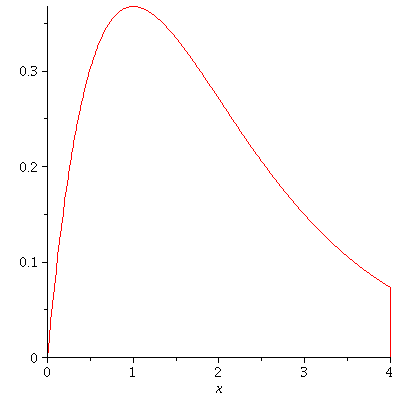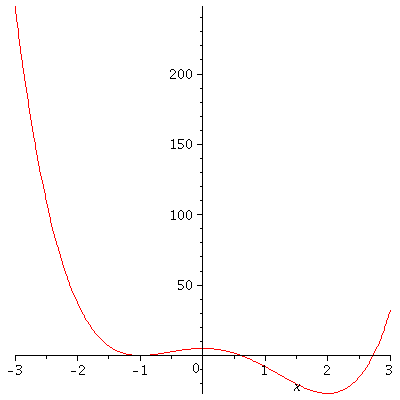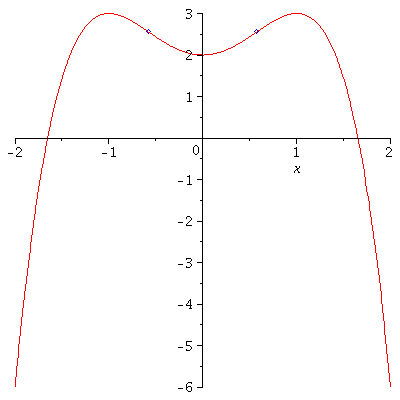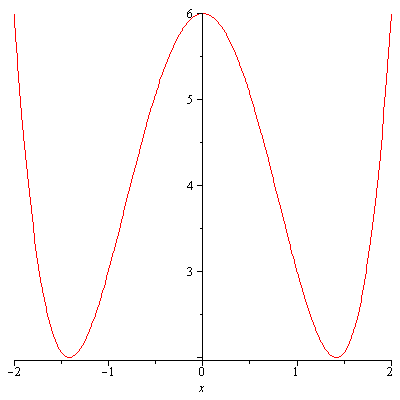Let us attempt to calculate $\int\cos^n xdx$ where $n$ is a positive integer. In the following table, the first column represents $\cos^{n-1}x$ and its derivative, and the second column represents $\cos x$ and its integral.
$$\begin{array}{ccc}
\cos^{n-1}x & & \cos x\\
&\stackrel{+}{\searrow}&\\
-(n-1)\cos^{n-2}x\sin x & \stackrel{-}{\longrightarrow} & \sin x\\
\end{array}$$
By integration by parts, we have
\begin{align*}
\int\cos^n xdx&=\cos^{n-1}x\sin x+(n-1)\int\cos^{n-2}x\sin^2xdx\\
&=\cos^{n-1}x\sin x+(n-1)\int\cos^{n-2}xdx-(n-1)\int\cos^{n-1}xdx+C’
\end{align*}
where $C’$ is a constant. Solving this for $\int\cos^nxdx$, we obtain
\begin{equation}
\label{eq:cosred}
\int\cos^n xdx=\frac{1}{n}\cos^{n-1}x\sin x+\frac{n-1}{n}\int\cos^{n-2}xdx+C
\end{equation}
where $C=\frac{C’}{n}$. The formula such as \eqref{eq:cosred} is called a reduction formula. Similarly we obtain the following reduction formulae.
\begin{align}
\int\sin^n xdx&=-\frac{1}{n}\sin^{n-1}x\cos x+\frac{n-1}{n}\int\sin^{n-2}dx\\
\int\tan^nxdx&=\frac{1}{n-1}\tan^{n-1}x-\int\tan^{n-2}dx,\ n\ne 1\\
\int\sec^nxdx&=\frac{1}{n-1}\sec^{n-2}x\tan x+\frac{n-2}{n-1}\int\sec^{n-2}xdx,\ n\ne 1
\end{align}
Example. Use the reduction formula \eqref{eq:cosred} to evaluate $\int\cos^3xdx$.
Solution.
\begin{align*}
\int\cos^3xdx&=\frac{1}{3}\cos^2x\sin x+\frac{2}{3}\int\cos xdx\\
&=\frac{1}{3}\cos^2x\sin x+\frac{2}{3}\sin x+C,
\end{align*}
where $C$ is a constant.
Integral like the following example is rather tricky.
Example. Evaluate $\int\sec xdx$.
Solution.
\begin{align*}
\int\sec xdx&=\int\sec x\frac{\sec x+\tan x}{\sec x+\tan x}dx\\
&=\int\frac{\sec^2x+\sec x\tan x}{\sec x+\tan x}dx\\
&=\frac{du}{u}\ (\mbox{substitution}\ u=\sec+\tan x)\\
&=\ln|u|+C\\
&=\ln|\sec x+\tan x|+C,
\end{align*}
where $C$ is a constant.
Example. Evaluate $\int\csc xdx$.
Solution. It can be done similarly to the previous example.
\begin{align*}
\int\csc xdx&=\int\csc x\frac{\csc x+\cot x}{\csc x+\cot x}dx\\
&=-\ln|\csc x+\cot x|+C,
\end{align*}
where $C$ is a constant. Note \begin{align*}-\ln|\csc x+\cot x|&=\ln\left|\frac{1}{\csc x+\cot x}\right|\\&=\ln\left|\frac{\csc x-\cot x}{\csc^2x-\cot^2}\right|\\&=\ln|\csc x-\cot x|\end{align*} since $\csc^2\theta+1=\cot^2\theta$. Thus, $\int\csc xdx$ can be also written as $$\int\csc xdx=\ln|\csc x-\cot x|+C$$
Evaluating Integrals of the Type $\int\sin^mx\cos^nxdx$ Where $m,n$ Are Positive Integers
Case 1. One of the integer powers, say $m$, is odd.
$m=2k+1$ for some integer $k$. So,
\begin{align*}
\sin^mx&=\sin^{2k+1}x\\
&=(\sin^2x)^k\sin x\\
&=(1-\cos^2x)^k\sin x.
\end{align*}
Use the substitution $u=\cos x$ in this case.
Example. Evaluate $\int\sin^3x\cos^2xdx$.
Solution.
\begin{align*}
\int\sin^3x\cos^2xdx&=\int \sin^2x\sin x\cos^2xdx\\
&=\int(1-\cos^2x)\cos^2x\sin xdx\\
&=-\int(1-u^2)u^2du\ (\mbox{substition}\ u=\cos x)\\
&=\frac{u^5}{4}-\frac{u^3}{3}+C\\
&=\frac{\cos^5x}{5}-\frac{\cos^3x}{3}+C,
\end{align*}
where $C$ is a constant.
Example. Evaluate $\int\cos^3xdx$.
Solution.
\begin{align*}
\int\cos^3xdx&=\int\cos^2x\cos xdx\\
&=\int(1-\sin^2x)\cos xdx\\
&=\int(1-u^2)du\ (\mbox{substitution}\ u=\sin x)\\
&=u-\frac{u^3}{3}+C\\
&=\sin x-\frac{\sin^3x}{3}+C,
\end{align*}
where $C$ is a constant.
Case 2. If both $m$ and $n$ are even.
In this case, use the trigonometric identities
$$\sin^2x=\frac{1-\cos 2x}{2},\ \cos^2x=\frac{1+\cos 2x}{2}.$$
Example. Evaluate $\int\sin^2x\cos^4xdx$.
Solution. $$\cos^4x=(\cos^2x)^2=\left(\frac{1+\cos 2x}{2}\right)^2\\=\frac{1}{4}(1+\cos 2x)^2$$ so \begin{align*}\int\sin^2x\cos^4xdx&=\frac{1}{8}\int(1-\cos 2x)(1+\cos 2x)^2dx\\&=\frac{1}{8}\int(1-\cos^2 2x)(1+\cos 2x)dx\\&=\frac{1}{8}\int(1+\cos 2x-\cos^22x-\cos^32x)dx\end{align*}\begin{align*}\int\cos^32xdx&=\int\cos^22x\cos 2xdx\\&=\int(1-\sin^22x)\cos 2xdx\\&=\int (1-u^2)du\ (\mbox{substitution}\ u=\sin 2x)\\&=u-\frac{u^3}{3}\\&=\sin 2x-\frac{\sin^32x}{3}\end{align*} \begin{align*}\int\cos^22xdx&=\int\frac{1+\cos 4x}{2}dx\\&=\frac{x}{2}+\frac{1}{8}\sin 4x\end{align*} (For these integrals the constant of integration has been neglected.) Therefore, $$\int\sin^2x\cos^4xdx=\frac{1}{16}\left(x-\frac{1}{4}\sin 4x+\frac{1}{3}\sin^32x\right)+C$$
where $C$ is a constant.
Update: I realized that the calculation above is more complicated than it should. Here is a simpler version. \begin{align*}\int\sin^2x\cos^4xdx&=\frac{1}{8}\int(1-\cos 2x)(1+\cos 2x)^2dx\\&=\frac{1}{8}\int(1-\cos^2 2x)(1+\cos 2x)dx\\&=\frac{1}{8}\int\sin^22x(1+\cos 2x)dx\\&=\frac{1}{8}\left[\int\sin^22xdx+\int\sin^22x\cos 2xdx\right]\\&=\frac{1}{8}\left[\frac{1}{2}\int(1-\cos 4x)dx+\frac{1}{2}\int u^2du\right]\ (\mbox{For the second integral substitution}\ u=\sin 2x\ \mbox{is used})\\&=\frac{1}{16}\left[x-\frac{1}{4}\sin 4x+\frac{u^3}{3}\right]+C\\&=\frac{1}{16}\left[x-\frac{1}{4}\sin 4x+\frac{1}{3}\sin^32x\right]+C\end{align*}
Integrals of Powers of $\tan x$ and $\sec x$
This type of integrals can be mostly done by using the trigonometric identity
$$1+\tan^2x=\sec^2x.$$
Example. Evaluate $\int\tan^4xdx$.
Solution.
\begin{align*}
\int\tan^4xdx&=\int\tan^2x\tan^2xdx\\
&=\int\tan^2x(\sec^2x-1)dx\\
&=\int\tan^2x\sec^2xdx-\int\tan^2xdx\\
&=\int u^2du-\int(\sec^2x-1)dx\ (\mbox{substition}\ u=\tan x)\\
&=\frac{\tan^3x}{3}-\tan x+x+C,
\end{align*}
where $C$ is a constant.
Example. Evaluate $\int\sec^3xdx$.
Solution.
\begin{align*}
\int\sec^3xdx&=\int\sec x\sec^2xdx\\
&=\sec x\tan x-\int\tan^2x\sec xdx\ (\mbox{integration by parts})\\
&=\sec x\tan x-\int(\sec^2x-1)\sec xdx\\
&=\sec x\tan x-\int\sec^3xdx+\int\sec xdx+C’\\
&=\sec x\tan x-\int\sec^3xdx+\ln|\sec x+\tan x|+C’,
\end{align*}
where $C’$ is a constant. Hence,
$$\int\sec^3xdx=\frac{1}{2}\sec x\tan x+\frac{1}{2}\ln|\sec x+\tan x|+C,$$
where $C=\frac{C’}{2}$.
Update: Alternatively, \begin{align*}
\int\sec^3xdx&=\int\sec x\sec^2xdx\\&=\int\sec x(1+\tan^2x)dx\\&=\int\sec xdx+\int\tan x(\sec x\tan xdx)\\
&=\ln|\sec x+\tan x|+\sec x\tan x-\int\sec^3xdx+C’\ (\mbox{integration by parts})
\end{align*}
where $C’$ is a constant. Hence,
$$\int\sec^3xdx=\frac{1}{2}\sec x\tan x+\frac{1}{2}\ln|\sec x+\tan x|+C,$$
where $C=\frac{C’}{2}$.
Products of Sines and Cosines
This type of integrals include $\int\sin mx\cos nxdx$, $\int\sin mx\cos nxdx$, and $\int\cos mx\cos nxdx$. In this case use the identities
\begin{align*}
\sin mx\sin nx&=\frac{1}{2}[\cos(m-n)x-\cos(m+n)x]\\
\sin mx\cos nx&=\frac{1}{2}[\sin(m-n)x+\sin(m+n)x]\\
\cos mx\cos nx&=\frac{1}{2}[\cos(m-n)x+\cos(m+n)x]
\end{align*}
Example. Evaluate $\int\sin 3x\cos5xdx$.
Solution.
\begin{align*}
\int\sin 3x\cos5xdx&=-\frac{1}{2}\int\sin 2x+\frac{1}{2}\int\sin 8xdx\\
&=\frac{1}{4}\cos 2x-\frac{1}{16}\cos 8x+C,
\end{align*}
where $C$ is a constant.
Example. Evaluate $\int_0^1\sin m\pi x\sin n\pi xdx$ and $\int_0^1\cos m\pi x\cos n\pi xdx$ where $m$ and $n$ are positive integers.
Solution. If $m=n$, then
\begin{align*}
\int_0^1\sin m\pi x\sin n\pi xdx&=\int_0^1\sin^2m\pi xdx\\
&=\int_0^1\frac{1-\cos 4m\pi x}{2}dx\\
&=\frac{1}{2}\int_0^1dx-\frac{1}{2}\int_0^1\cos 4m\pi xdx\\
&=\frac{1}{2}-\frac{1}{8m\pi}[\sin 4m\pi x]_0^1\\
&=\frac{1}{2}.
\end{align*}
Now we assume that $m\ne n$. Then
\begin{align*}
\int_0^1\sin m\pi x\sin n\pi xdx&=\frac{1}{2}\int_0^1\cos(m-n)\pi xdx-\frac{1}{2}\int_0^1\cos(m+n)\pi xdx\\
&=0.
\end{align*}
So, we can simply write the integral as
\begin{equation}
\label{eq:orthofunct}
\int_0^1\sin m\pi x\sin n\pi xdx=\frac{1}{2}\delta_{mn},
\end{equation}
where
$$\delta_{mn}=\left\{\begin{array}{ccc}
1 & \mbox{if} & m=n,\\
0 & \mbox{if} & m\ne 0.
\end{array}\right.$$
$\delta_{mn}$ is called the Kronecker’s delta.
Similarly, we also have
\begin{equation}
\label{eq:orthofunct2}
\int_0^1\cos m\pi x\cos n\pi xdx=\frac{1}{2}\delta_{mn}.
\end{equation}
The integrals \eqref{eq:orthofunct} and \eqref{eq:orthofunct2} play an important role in studying the boundary value problems with heat equation and wave equation. They also appear in the study of different branches of mathematics and physics such as functional analysis, Fourier analysis, electromagnetism, and quantum mechanics, etc. In mathematics and physics, often functions like $\sin n\pi x$ and $\cos n\pi x$ are treated as vectors and integrals like \eqref{eq:orthofunct} and \eqref{eq:orthofunct2} can be considered as inner products $\langle\sin m\pi x,\sin n\pi x\rangle$ and $\langle\cos m\pi x,\cos n\pi x\rangle$, respectively. In this sense, we can say that $\sin m\pi x$ and $\sin n\pi x$ are orthogonal if $m\ne n$. For this reason, functions $\sin n\pi x$ and $\cos n\pi x$, $n=1,2,\cdots$ are called orthogonal functions.




